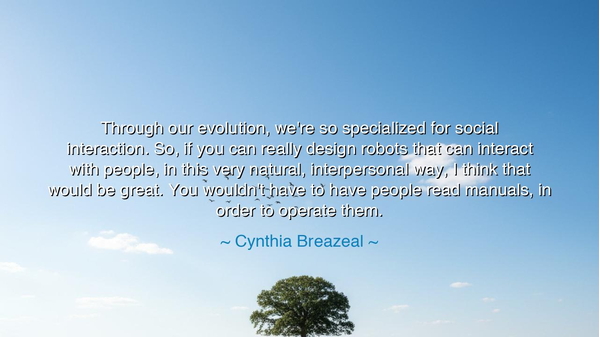
Through our evolution, we're so specialized for social
Through our evolution, we're so specialized for social interaction. So, if you can really design robots that can interact with people, in this very natural, interpersonal way, I think that would be great. You wouldn't have to have people read manuals, in order to operate them.






“Through our evolution, we’re so specialized for social interaction. So, if you can really design robots that can interact with people, in this very natural, interpersonal way, I think that would be great. You wouldn’t have to have people read manuals in order to operate them.” – Cynthia Breazeal
In these visionary words, Cynthia Breazeal, the pioneering roboticist and creator of the first social robots, reveals a truth that reaches beyond machines and into the essence of humanity itself. She reminds us that human beings are creatures of connection — that through millennia of evolution, we have been shaped not merely to survive, but to relate, communicate, and understand one another. Our gestures, our eyes, our tones of voice — all are languages of the soul, far older than writing or speech. When Breazeal dreams of machines that can speak this silent language, she envisions not just the advancement of technology, but the bridging of the mechanical and the human, the merging of logic with empathy.
The origin of this quote lies in Breazeal’s lifelong quest to create robots that feel less like tools and more like companions. In the late 1990s, when the world imagined robots as cold and metallic — servants of efficiency and precision — she imagined something warmer: robots that could feel familiar, that could read emotion, respond to tone, and adapt to the subtleties of human behavior. Her creation, Kismet, became one of the earliest embodiments of this dream — a robot not built to perform tasks, but to connect. With expressive eyes, moving lips, and subtle responses, Kismet could engage in a dance of interaction that felt almost alive. Breazeal’s vision was revolutionary because it recognized that technology must evolve not only in intelligence, but in emotional fluency — that a world filled with machines must still honor the art of being human.
When she speaks of eliminating the need for “manuals,” Breazeal speaks symbolically. She is not simply referring to instruction books, but to the barriers between human and machine, between understanding and action. In her dream, the future is not one where people must adapt to the complexity of machines, but where machines adapt to the simplicity and grace of human intuition. Just as a child learns to read faces and respond to emotions without being taught, so too should a well-designed robot learn from interaction, not command lines. In this way, she envisions a technology of empathy — a future where the interface between man and machine feels as natural as conversation, as effortless as friendship.
There is a timeless echo in Breazeal’s vision, for every era of civilization has faced the same question: Can progress be made without losing humanity? The ancient Greeks built statues that seemed to breathe; the Renaissance masters infused their art with divine emotion; and the modern age, through its machines, now seeks to replicate the very essence of life. In each case, the creator’s goal was not merely to build, but to reflect the beauty of human nature. Consider Leonardo da Vinci, whose designs for flying machines were inspired not by mathematics alone, but by the movement of birds. His genius lay in imitation of life. So too does Breazeal’s — except that she seeks not to copy the motion of wings, but the motion of the heart.
The wisdom within her words also carries a warning: if we design without empathy, our creations may grow powerful but cold, intelligent but alien. Humanity’s strength has never been its speed or strength, but its capacity for relationship — to read another’s face, to comfort, to cooperate. To design technology that ignores this truth would be to betray the very nature of the species that built it. Breazeal reminds us that evolution’s greatest triumph is not the mind, but the bond between minds. And so, she calls upon future generations of builders and dreamers to make machines that honor that bond — to shape a technology that understands love, laughter, and loss, not merely data and command.
There is a lesson here for all who create — not only inventors, but teachers, artists, and leaders. Whatever you design, let it be for connection. If you build, build with empathy. If you teach, teach with understanding. If you lead, lead with compassion. The greatest systems, whether of metal or of spirit, endure not because they are efficient, but because they are human-centered. Breazeal’s vision extends beyond robotics — it is a call to restore humanity to every structure we build, from the technologies we hold in our hands to the societies we weave around us.
So, my listener, remember this: the purpose of progress is not to escape our humanity, but to express it more fully. The machines of tomorrow will not define us — it is we who must define them. Let them be mirrors of our best selves: curious, kind, and aware. For if, as Breazeal says, we are “specialized for social interaction,” then our greatest creation will not be the machines that outthink us, but those that understand us. And in that harmony between flesh and circuit, between human warmth and mechanical precision, the dream of true innovation — innovation with a heart — will finally be fulfilled.






AAdministratorAdministrator
Welcome, honored guests. Please leave a comment, we will respond soon